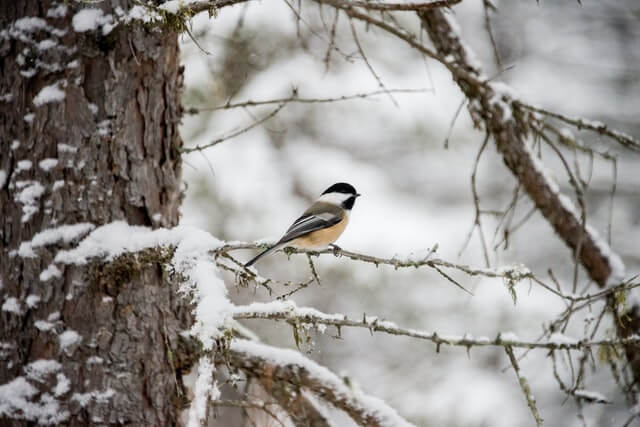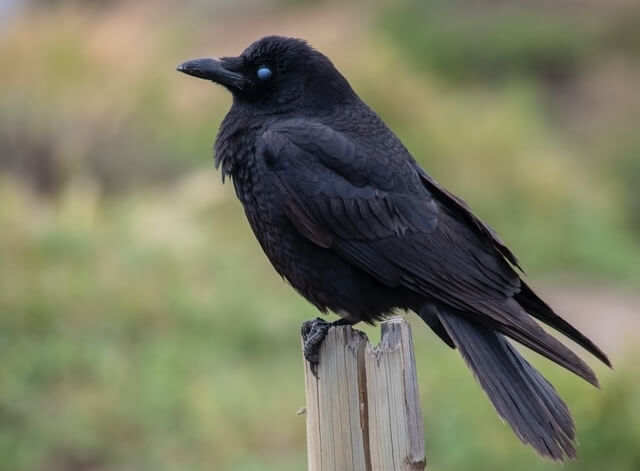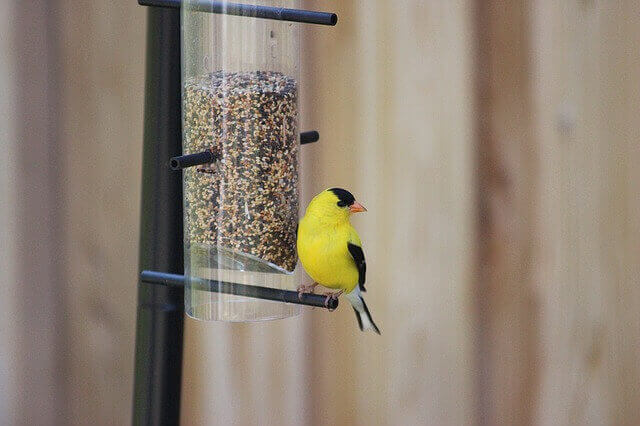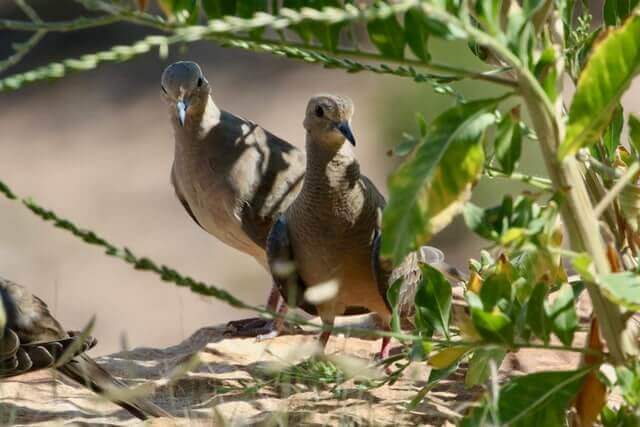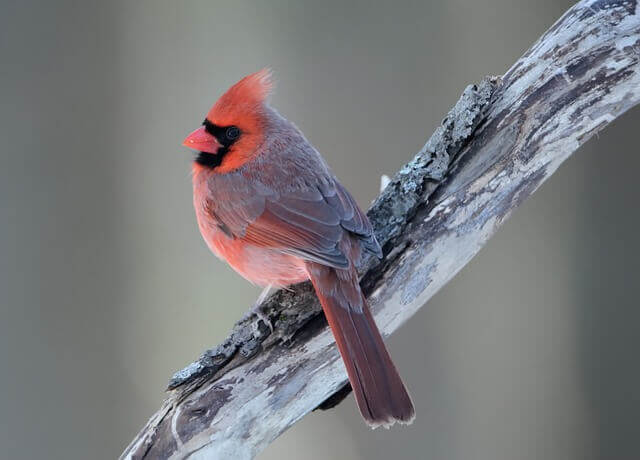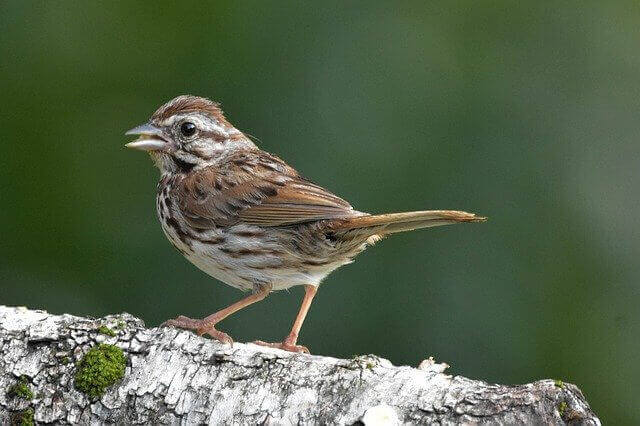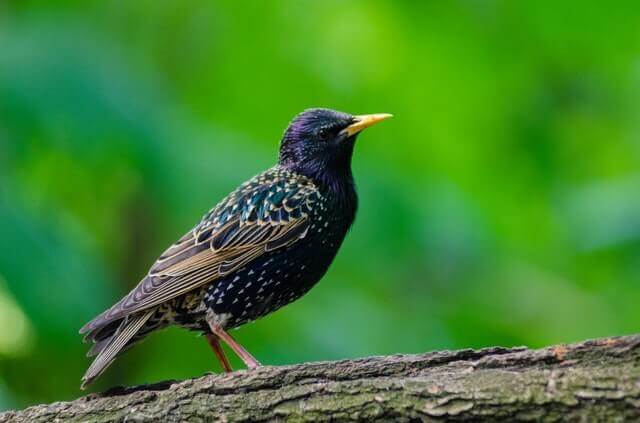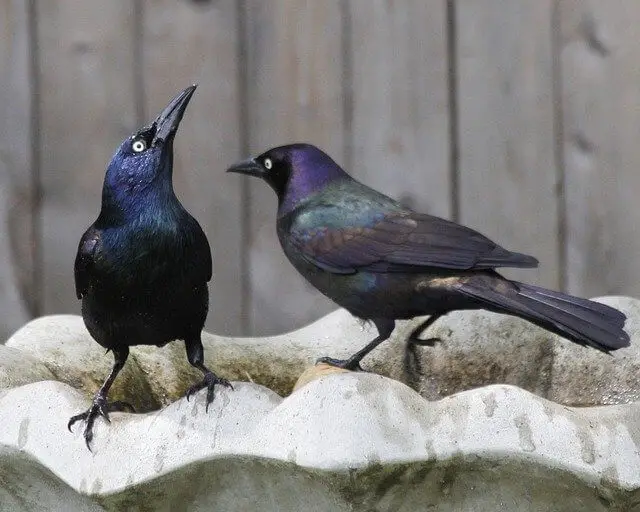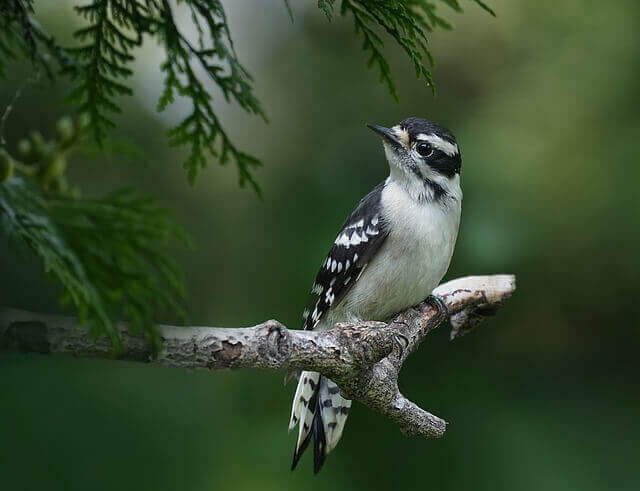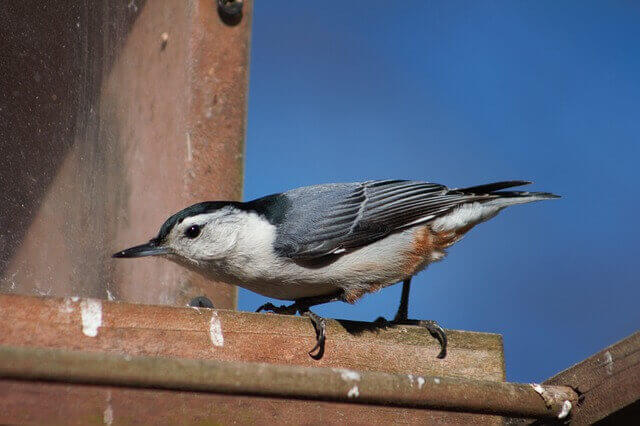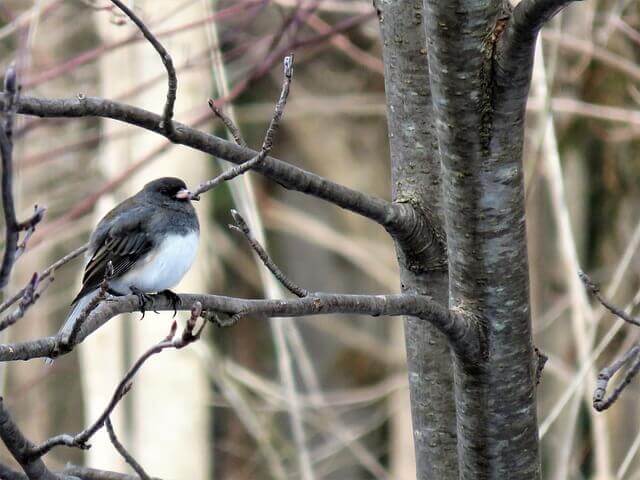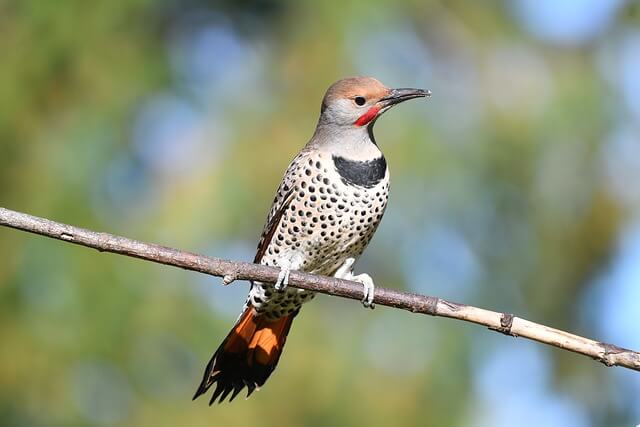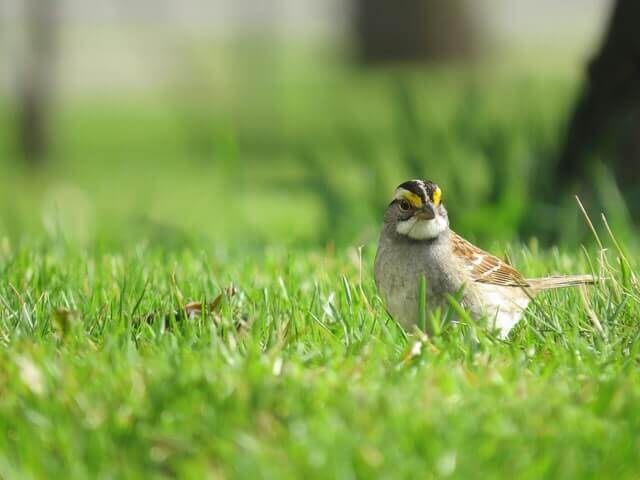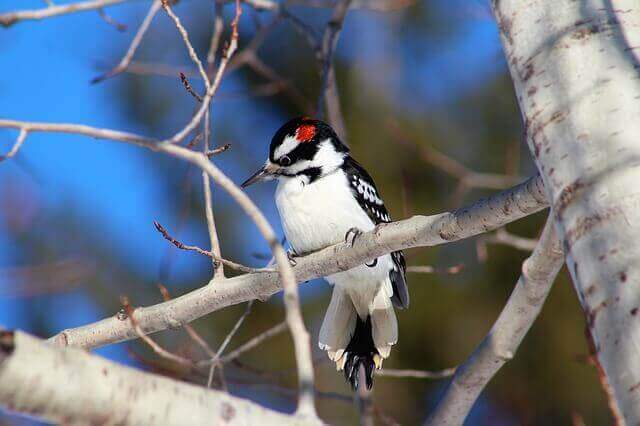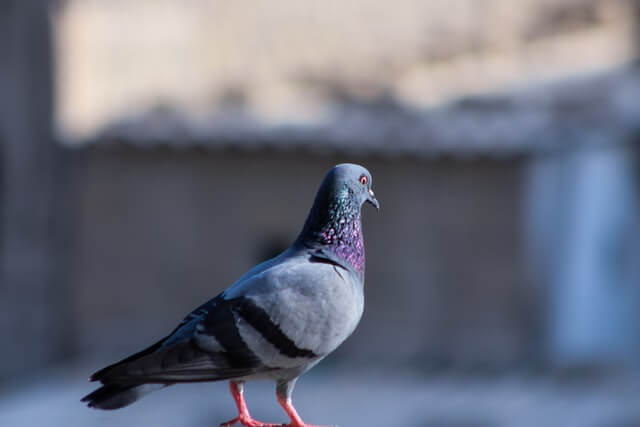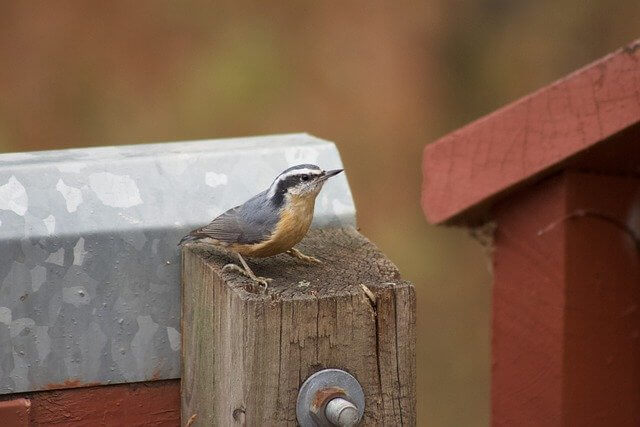Discover Ontario’s diverse birding landscapes! From lush forests to serene lakes, Ontario offers a rich tapestry of bird species waiting to be explored. In this guide, we’ll introduce you to the 53 most common birds you’re likely to encounter across the province, catering to both seasoned birders and newcomers alike.
Table of Contents
- 1 Most Common Birds in Ontario Canada
- 1.1 Black-capped Chickadee
- 1.2 American Robin
- 1.3 American Crow
- 1.4 Blue Jay
- 1.5 American Goldfinch
- 1.6 Red-winged Blackbird
- 1.7 Mourning Dove
- 1.8 Northern Cardinal
- 1.9 Song Sparrow
- 1.10 European Starling
- 1.11 Common Grackle
- 1.12 Downy Woodpecker
- 1.13 White-breasted Nuthatch
- 1.14 House Sparrow
- 1.15 Dark-eyed Junco
- 1.16 Northern Flicker
- 1.17 White-throated Sparrow
- 1.18 Hairy Woodpecker
- 1.19 Rock Pigeon
- 1.20 Chipping Sparrow
- 1.21 Red-breasted Nuthatch
- 2 Frequently Asked Questions
- 3 Author
Most Common Birds in Ontario Canada
Black-capped Chickadee
One of North America’s most recognizable birds, the black-capped chickadee can be found in a variety of places throughout the continent. A popular winter visitor to backyards is the chickadee. During this time of year these birds are usually singing, but they also appear in other seasons, as well.
In southern Ontario, Canada, black-capped chickadees are a familiar sight on the margins of rolling hills and small meadows, often foraging for grass and other food sources before winter. The bird’s song is especially enjoyable during this time of year. One of the most popular places to find the bird is in a birch tree.
- Frequency: 46.69% (Statistic: eBird)
- Color: Black-cap, white on face, white/reddish-brown flanks
- Habitat: Deciduous and mixed forests, backyards, parks
- Range: USA and Canada
- Size: 11.5 -16 cm length
- Weight: 8 – 15 grams
- Diet: Insects, seeds, berries
- Family: Paridae
- Genus: Poecile
- Maps: Range Map – Sightings Map
- Sounds: Call and Songs
Related: How Do I Attract Chickadees To My Yard?
American Robin
The American Robin is a migratory songbird that breeds in much of North America. Robins are popular birds for their cheery songs and their redbreasts. The males sing a series of 5-6 short notes followed by a trill, while the females sing a shorter version of this song. The American Robin has a large range, extending from Alaska and Canada to Mexico.
This bird is found in forests, woodlands, gardens, and lawns. Diet consists mainly of insects, but also include earthworms, berries, and fruits. Robins are generally monogamous and pairs stay together during the breeding season, which typically lasts from late March to early August.
- Frequency: 42.34%
- Color: Mostly brown on the back with an orange colored breast
- Habitat: Wooded areas, backyards, parks, fields
- Range: USA, Canada, Mexico
- Size: 12 – 16″ inches
- Weight: 72 – 95 grams
- Diet: Fruits, berries and insects (earthworms, beetles, caterpillars
- Family: Turdidae
- Genus: Turdus
- Maps: Range Map – Sightings Map
- Sounds: Call and Songs
Related:
- Interesting American Robin Fun Facts
- How To Attract Robins To Your Yard – 7 Best Tips!
- 5 Best Bird Feeders For Robins (Tested & Rated For 2022)
American Crow
The American Crow (Corvus brachyrhynchos) is a medium-sized bird that is a member of the Corvidae family. The American crow is found in North America and its range extends from southern Canada to northern Mexico. The American crow prefers to live in open habitats such as forests, fields, and parks. The American crow feeds on a variety of food items including insects, small mammals, berries, and garbage.
The bird will also prey on other birds, which has led to the American crow being considered a nuisance by some people. In addition to its diet, the American crow will also eat carrion (dead animals). The American crow is a highly intelligent bird and has been known to use tools to obtain food. The bird has also been observed using different calls to communicate with other members of its species.
- Frequency: 39.70%
- Color: Black
- Habitat: Open country, farms, parks, woodlands, towns, cities
- Range: Canada, USA, Mexico
- Size: 16 – 21″ inches
- Weight: 315 -620 grams
- Diet: invertebrates, carrion, seeds, eggs fish, grains, mice, frogs, and other small animals.
- Family: Corvidae
- Genus: Corvis
- Maps: Range Map – Sightings Map
- Sounds: Call and Songs
Related: How To Attract Crows To Your Backyard: Expert Tips!
Blue Jay
The Blue Jay is a corvid in the crow family. It is a small to medium-sized bird with a body length of 9 to 10 inches and a wingspan of 13 to 17 inches. The Blue Jay has blue upper parts, white underparts, and a blue crest. The bill is black, and the legs and feet are the same. The Blue Jay has a range that extends from southern Canada to northern Mexico.
In the United States, it is found in the eastern and central states. The Blue Jay prefers woodlands, but it can also be found in parks and suburban areas. The diet of the Blue Jay consists mainly of acorns, nuts, seeds, insects, and fruits. It will also eat eggs and nestlings of other birds.
- Frequency: 38.62%
- Color: Blue crest on the head, wings, back, and tail, and has a white face and belly
- Habitat: Deciduous and mixed forests, mixed woodlands, backyards, parks
- Range: Southern Canada, Eastern and Central United States, Florida and Texas
- Size: 8 – 12″ inches
- Weight: 70 – 100 grams
- Diet: Nuts, seeds, caterpillars, grasshoppers, and beetles
- Family: Corvidae
- Genus: Cyanocitta
- Maps: Range Map – Sightings Map
- Sounds: Call and Songs
Related:
- How to Attract Blue Jays to your Yard?
- 15 Best Bird Feeders For Blue Jays (Tried & Tested 2022)
- Do Blue Jays Migrate? The Truth
- What do Blue Jay Eat – All The Facts
American Goldfinch
The American Goldfinch (Spinus tristis) is a small North American finch that feeds primarily on seeds. The male goldfinch has a bright yellow body with black wings and tail, while the female is more drab, with gray-brown wings and tail. These birds are often seen in flocks feeding on thistle seedheads or clinging to sunflowers.
American goldfinches breed across most of Canada and the United States. They typically nest in trees or shrubs, lining their nests with soft materials such as thistle down. In winter, these birds often form large flocks and can be found in open woodlands, weedy fields, and along roadsides. These birds are mostly granivorous, feeding on a variety of seeds including those from dandelions, thistles, and conifers.
- Frequency: 36.72%
- Color: Face, neck, and underside are yellow, black wings with white bars
- Habitat: Deciduous forests and thickets, roadside, grasslands, backyards, meadows
- Range: Canada, USA and Mexico
- Size: 4.3 – 5.5″ inches length
- Weight: 12 -18 grams
- Diet: Grass, dandelions, chickweed, sunflowers and ragweed, thistle, red alder, birch, spruce seeds
- Family: Carduelinae
- Genus: Spinus
- Maps: Range Map – Sightings Map
- Sounds: Call and Songs
Related: American Goldfinch Interesting Facts
Red-winged Blackbird
The Red-winged Blackbird (Agelaius phoeniceus) is a type of true blackbird in the family Icteridae. The red-winged blackbird is sexually dimorphic, meaning that the male and female have different plumage. The male has all-black feathers with a glossy sheen and two bright red shoulder patches, or “epaulets”.
The female usually has dark brown feathers with some streaking on her wings and tail. Both sexes have yellow eyes and bills. The red-winged blackbird is found in North America, from Alaska and Canada to Mexico. It is a very adaptable bird and can be found in a variety of habitats, including marshes, swamps, woodlands, fields, and even urban areas.
- Frequency: 32.05%
- Color: All black with red patches on shoulder and a yellow wing bar.
- Habitat: Deciduous forests, conifers, roadside, rivers, backyards, parks.
- Range: North America, Central America
- Size: 6.7 – 7.1″ inches length
- Weight: 41.5 – 65 grams
- Diet: Seeds and insects (butterflies, dragonflies, moths, frogs, worms, spider, snails, carrion, flies.)
- Family: Icteridae
- Genus: Agelaius
- Maps: Range Map – Sightings Map
- Sounds: Call and Songs
Mourning Dove
The Mourning Dove is a widespread bird found throughout North America. It is a common bird in open habitats such as farmland, prairies, and urban parks and gardens. The Mourning Dove is a medium-sized dove with a slender body and long tail. It is gray-brown above with pale underparts and has a black band on its wings. The Mourning Dove is named for its call, which sounds like someone mourning
The Mourning Dove ranges from southern Canada to northern Mexico. It breeds across most of the United States and southern Canada. The Mourning Dove is migratory, moving south in the fall to escape the cold winter weather. It can be found year-round in some parts of the southern United States.
- Frequency: 31.58%
- Color: Light gray-brown and lighter and pinkish below. The wings have black spots.
- Habitat: Open habitats, urban areas, farms, prairie, grassland, wooded area
- Range: USA, Canada, Mexico, Central America, Greater Antilles
- Size: 12″ inches length
- Weight: 112 – 170 grams
- Diet: Rapeseed, corn, millet, safflower, sunflower seeds, pokeberry, sesame, and wheat.
- Family: Columbidae
- Genus: Zenaida
- Maps: Range Map – Sightings Map
- Sounds: Call and Songs
Related:
- Facts About Mourning Doves – 10 Things You Need To Know!
- Best Bird Feeder For Doves (Reviewed & Tested for 2022)
Northern Cardinal
The Northern Cardinal is a North American bird that ranges from southern Canada to northern Mexico. It is the designated state bird of seven U.S. states. The Northern Cardinal is a habitat generalist, meaning it can live in a variety of habitats including forests, woodlands, gardens, and even cities. Cardinals are not migratory birds, so they can be found in their range year-round.
The diet of the Northern Cardinal consists mainly of seeds and insects. Cardinals will also eat fruits and berries. During the winter months, when food is scarce, birds will often visit backyard bird feeders to supplement their diet.
- Frequency: 31.27%
- Color: Mostly red with a black mask on the face, short pink bill
- Habitat: woodlands, gardens, parks, backyards, and wetlands
- Range: USA, Canada, Mexico
- Size: 8.2 – 9.3″ inches
- Weight: 33 – 65 grams
- Diet: Fruits, berries, and insects (grasshoppers, beetles, snails, cicadas)
- Family: Cardinalidae
- Genus: Cardinalis
- Maps: Range Map – Sightings Map
- Sounds: Call and Songs
Related:
- 10 Best Bird Feeders for Cardinals (Rated for 2022)
- Best Birdhouse for Cardinals 2022 (Tested And Rated)
- Where are Cardinal Birds Found – Best Places to Look
- Cardinal Bird Facts You Never Knew
Song Sparrow
The Song Sparrow, Melospiza melodia, is a small bird that breeds in North America. It’s part of the New World sparrow family. The song sparrow is one of the most widespread and abundant birds in North America. It has a large range, breeding from Alaska and Canada to Mexico and the Caribbean.
The song sparrow is found in a variety of habitats, including open woodlands, forests, meadows, gardens, and city parks. It is an adaptable bird and can even nest in urban areas. The diet of the song sparrow consists mostly of insects and seeds. In winter, when insects are scarce, the bird will eat more seeds.
- Frequency: 30.60%
- Color: Gray head, white cheek, a black bib, rufous neck
- Habitat: Urban centers, farms, backyards, edges, yards, and parks
- Range: Europe, Mediterranean, Asia, Australasia, Africa, and the Americas
- Size: 5.5 – 7.0″ inches
- Weight: 25 – 40 grams
- Diet: Grains, seeds, and insects
- Family: Passeridea
- Genus: Passer
- Maps: Range Map – Sightings Map
- Sounds: Call and Songs
Related: How to Attract Sparrows to your Backyard
European Starling
The European Starling is a species of starling in the family Sturnidae. The species is also known as the common starling, or simply the starling, in the British Isles. It is an omnivorous passerine bird that is native to Europe, Asia and North Africa. The European starling has a large range, with an estimated global population of 250 million birds.
The bird is highly adaptable and has adapted well to human activity and habitat alteration. The European starling is a widespread breeder in North America, Europe, Asia and North Africa. The bird breeds in a wide variety of habitats, including urban areas, farmland, forests and wetlands. The European starling diet consists mainly of invertebrates, but the bird will also consume fruits and berries.
- Color: Black with glossy iridescence plumage
- Habitat: Forests, woodlands, backyards, edges, yards, and parks
- Range: North America, Europe, Africa, India, Middle East, China
- Size: 7 – 9″ inches long
- Weight: 60 – 100 grams
- Diet: Insects (ants, beetles, invertebrates), fruits, seeds, berries
- Family: Sturnidae
- Genus: Sturnus
- Maps: Range Map – Sightings Map
- Sounds: Call and Songs
Related: How To Attract European Starlings To Your Yard Fast?
Common Grackle
The Common Grackle is a species of bird that can be found in North and South America. These birds are usually black, but they can also be brown or purple iridescent. The common grackle has a long tail and a short beak. These birds are usually about 11 inches long. The common grackle can be found in open areas such as fields, parks, and marshes.
These birds prefer to live in areas where there are trees nearby. The common grackle is not afraid of humans and will often approach them. The diet of the common grackle consists of insects, earthworms, frogs, lizards, and small mammals. These birds will also eat fruits and berries. The common grackle is known to eat garbage if it is available.
- Frequency: 26.93%
- Color: Black overall with a blue, and purple iridescence. Its body plumage is a shimmering copper color.
- Habitat: Woodlands, marshes, meadows, parks, backyards, and fields
- Range: East of the Canadian Rockies, Canada and the United States
- Size: 11 – 13″ inches length
- Weight: 75 – 143 grams
- Diet: minnows, eggs, berries, seeds, grain, insects, frogs, mice
- Family: Icteridae
- Genus: Quiscalus
- Maps: Range Map – Sightings Map
- Sounds: Call and Songs
Downy Woodpecker
The Downy Woodpecker is a bird that can be found in North America. It has a black body with a white back and wings. The male has a red patch on the back of its head, while the female does not. The downy woodpecker is the smallest woodpecker in North America.
The downy woodpecker can be found in forests, woods and parks. It is a common bird that is found throughout the continent. The downy woodpecker feeds on insects, spiders, berries and fruits. It uses its long tongue to reach into crevices to find food. The downy woodpecker often feeds on tree sap as well.
- Frequency: 25.09%
- Color: Black with a white throat, belly, and back. White spots on wings
- Habitat: Deciduous forests and thickets, roadside, grasslands, backyards, parks
- Range: Canada, USA, and Mexico
- Size: 5.5 – 7.1″ inches in length
- Weight: 20 – 33 grams
- Diet: Mostly insects and beetles and ants, also gall wasps, caterpillars
- Family: Picadae
- Genus: Dryobates
- Maps: Range Map – Sightings Map
- Sounds: Call and Songs
Related: How to Attract Downy Woodpeckers to Your Yard? (Easy!)
White-breasted Nuthatch
The White-breasted Nuthatch is a small bird with a large head and a short tail. They are grayish-blue above and white below, with black streaks on their sides and chestnut brown under the tail. The male has a black cap, while the female has a gray cap. They are found in woodlands across North America.
The White-breasted Nuthatch is a cavity nester, meaning they will nest in holes in trees or man-made structures. They will also use nest boxes. These birds are non-migratory and will stay in their territory year-round. Their diet consists of insects, nuts, and seeds.
The White-breasted Nuthatch is a common bird that is easily recognizable by its call which sounds like it is saying “yank yank”.
- Frequency: 19.15%
- Color: Has a white face, flanks, and chest. It has a black cap on its head a bluish-gray upper and a brown belly
- Habitat: Deciduous forests, conifers, roadside, rivers, backyards, parks
- Range: Southern Canada, USA
- Size: 5.9″ inches
- Weight: 20 grams
- Diet: Acorn nuts, hickory nuts, ants, caterpillars, scale insects, pine weevils
- Family: Sittidae
- Genus: Sitta
- Maps: Range Map – Sightings Map
- Sounds: Call and Songs
Related: How to Attract Nuthatches to your Backyard
House Sparrow
The house sparrow is a small bird that is found in a wide range of habitats, from cities to rural areas. It has a diet that consists mainly of seeds and insects. The house sparrow has a wide range, extending from North America, Europe and Africa to Asia and Australasia.
In terms of habitat, the house sparrow can be found in many different types of habitat, including forests, grasslands, and urban areas. The house sparrow is an important bird in many ecosystems, as it helps to control insect populations and disperse seeds.
- Frequency: 18.75%
- Color: Gray head marking, a reddish-brown back, and gray underparts
- Habitat: Urban centers, suburban areas, backyards, edges, yards, and parks
- Range: North America, Central America, South America, Africa, Australia, New Zealand
- Size: 5.5 – 7.1″ inches in length
- Weight: 25 – 39 grams
- Diet: Insects, beetles, caterpillars, aphids,, grasshoppers, crustaceans, earthworms, vertebrates
- Family: Passeridea
- Genus: Passer
- Maps: Range Map – Sightings Map
- Sounds: Call and Songs
Dark-eyed Junco
The dark-eyed junco (Junco hyemalis) is a North American bird in the sparrow family. It is the best known and most widespread junco. There are several subspecies of dark-eyed junco, including the yellow-eyed junco of the Rocky Mountains. The dark-eyed junco ranges from Alaska and Canada to Mexico, and is found in all 48 contiguous U.S. states.
The dark-eyed junco breeds in coniferous forests, but in winter it can be found in a variety of habitats, including woodlands, fields, gardens, and city parks. The diet of the dark-eyed junco is mostly seeds and insects. In winter, when seed availability is low, the bird will visit bird feeders to supplement its diet.
- Frequency: 17.87%
- Color: Gray head, neck, breast, gray/brown backs and wings, white underside
- Habitat: Wooded areas, forest edges, roadsides, gardens, parks.
- Range: USA and Canada
- Size: 5.1 – 6.9″ inches
- Weight: 18 – 30 grams
- Diet: Seeds, insects, and arthropods
- Family: Passeriformes
- Genus: Junco
- Maps: Range Map – Sightings Map
- Sounds: Call and Songs
Related: Fun Facts About Dark-eyed Juncos
Northern Flicker
The Northern Flicker is a species of bird in the woodpecker family. The bird is also known as the Common Flicker. The Northern Flicker is the only member of the genus Colaptes in North America. The bird ranges from Alaska and Canada to Mexico. The preferred habitat of the Northern Flicker is open woodlands with plenty of trees for nesting and foraging.
This bird will also inhabit urban areas, including parks and gardens. The diet of the Northern Flicker consists mainly of insects, which it catches by probing into crevices in tree bark with its long tongue. The bird also feeds on fruits, berries, and seeds.
- Frequency: 15.25%
- Color: Light brown with black bars across back, chest, wings, belly
- Habitat: Forests, woodlands, backyards, edges, yards, and parks
- Range: North America, Central America, Cuba, Cayman Islands
- Size: 10 – 14″ inches
- Weight: 85 – 165 grams
- Diet: Insects (ants, beetles, invertebrates), fruits, seeds, berries
- Family: Picadae
- Genus: Colaptes
- Maps: Range Map – Sightings Map
- Sounds: Call and Songs
Related: How to Attract Northern Flickers to your Backyard
White-throated Sparrow
The White-throated Sparrow is a small songbird that breeds in the boreal forests of North America. It is a migratory bird, spending her winters in the southern United States and Mexico. The White-throated Sparrow has a white throat and breast, with grayish brown upperparts. The male has a black stripe down its center, while the female has a more diffuse grayish brown stripe.
The White-throated Sparrow’s diet consists of insects and seeds. In summer, its diet consists mainly of insects, while in winter it switches to seed eating. The White-throated Sparrow nests on the ground, usually in dense vegetation. It builds its nest out of grasses, leaves, and other plant material.
- Frequency: 13.51%
- Color: Brown and gray head pattern. Black-and-white-striped head, white throat, and some yellow near both eyes.
- Habitat: Deciduous forests and thickets, roadside, grasslands, backyards
- Range: Eastern North America, Atlantic Canada
- Size: 5.9″ – 7.5″ inches long
- Weight: 22 – 32 grams
- Diet: Seeds, insects, and berries
- Family: Passerellidae
- Genus: Zonotrichia
- Maps: Range Map – Sightings Map
- Sounds: Call and Songs
Hairy Woodpecker
The Hairy Woodpecker (Picoides villosus) is a medium-sized woodpecker found in North America. The Hairy Woodpecker ranges from Alaska and Canada to the Gulf States and Mexico. The Hairy Woodpecker is a non-migratory bird and will often remain in the same general area throughout its lifetime. The Hairy Woodpecker inhabits open woodlands, forests and parklands.
The Hairy Woodpecker is also commonly found near urban areas and backyards. The Hairy Woodpecker will excavate its own nesting cavity in trees, often using dead trees or branches. The diet of the Hairy Woodpecker consists mainly of insects and their larvae, although the bird will also eat berries, nuts and fruits.
- Frequency: 13.49%
- Color: Black and white checkered throughout, all white underside, has a mask
- Habitat: Wooded areas, forest edges, roadsides, gardens, parks.
- Range: USA and Canada
- Size: 7.0 – 10″ inches in length
- Weight: 40 – 95 grams
- Diet: Berries, seeds, nuts beetles, ants, caterpillars, and others.
- Family: Tyrannidae
- Genus: Tyrannus
- Maps: Range Map – Sightings Map
- Sounds: Call and Songs
Rock Pigeon
The rock pigeon (Columba livia) is a widespread species that is found on every continent except for Antarctica. These birds are most commonly seen in urban areas, where they have adapted to living in proximity to humans. Rock pigeons are typically gray with two black bars on their wings, but they can also be white, brown, or blue. These birds are proficient flyers and can reach speeds of up to 55 miles per hour.
Rock pigeons are generally found in open habitats such as grasslands, forests, and meadows. However, they have also adapted to living in more urbanized areas, such as parks and city streets. These birds typically eat seeds and fruits, but they will also consume leaves, buds, and insects if necessary.
- Frequency: 13.02%
- Color: Dark blue-gray head, neck, and chest with a yellow, green and red iridescence on its neck and wings.
- Habitat: Woodlands, marshes, meadows, parks, backyards, and fields
- Range: Europe, North Africa, South Asia, Canada and USA
- Size: 11 – 15″ inches long
- Weight: 235 – 380 grams
- Diet: They areomnivorous, but also like seeds, plant matter, sugary fruits and grains.
- Family: Columbidae
- Genus: Columba
- Maps: Range Map – Sightings Map
- Sounds: Call and Songs
Related: Birds that look like Pigeons (Photos, ID & Stats)
Chipping Sparrow
The Chipping Sparrow (Spizella passerina) is a small songbird of the New World sparrow family. It ranges from Alaska and Canada to Central America, and is one of the most widespread birds in North America. The chipping sparrow is a non-migratory bird, and can be found in a variety of habitats including forests, grasslands, and suburban areas.
The diet of the chipping sparrow consists primarily of insects and seeds. In the summer months, the bird will eat a greater variety of insects, including beetles, caterpillars, crickets, and grasshoppers. In the winter months, when insect populations are lower, the chipping sparrow will turn to seeds for food. The bird will also eat berries and other fruits when they are available.
- Frequency: 12.91%
- Color: Rust-colored upperparts, gray head, and underparts with a reddish cap on the head
- Habitat: Coniferous forests, woodland, farmland, parks, and gardens
- Range: Southern USA and Mexico
- Size: 4.7 – 5.9″ inches
- Weight: 11 – 16 grams
- Diet: Mostly seeds, spiders
- Family: Passerellidae
- Genus: Spizella
- Maps: Range Map – Sightings Map
- Sounds: Call and Songs
Red-breasted Nuthatch
The Red-breasted Nuthatch (Sitta canadensis) is a small songbird with a black cap and bluish-gray upperparts. The underparts are orange, and the bird has a black stripe, that goes across the eye on each side of its head. The red-breasted nuthatch is found in North America, from Alaska to Newfoundland south to California and Florida. The bird breeds in coniferous forests and winters in woodlands or suburban areas.
The red-breasted nuthatch feeds on insects and spiders, which it finds by probing the bark of trees with its bill. The bird also eats seeds and nuts, including acorns, beechnuts, and pine nuts. In winter, the red-breasted nuthatch often visits bird feeders.
- Frequency: 12.35%
- Color: Bluish gray upperparts with reddish brown underparts, a white face and throat with a black stripe runs through the eyes.
- Habitat: Coniferous trees but can also be found in mixed woods, backyards, and parks.
- Range: Canada and USA
- Size: 4.5″ inches long
- Weight: 9.9 grams
- Diet: Berries, suet, small seeds, carrion, grasshoppers, and various insect larvae, and crustaceans.
- Family: Sittidae
- Genus: Sitta
- Maps: Range Map – Sightings Map
- Sounds: Call and Songs
These common backyard birds all have a frequency of less than 12% year-round
- Tree Swallow 12.04% Frequency
- Killdeer 11.18%
- Red-eyed Vireo 10.83%
- Yellow Warbler 10.83%
- Cedar Waxwing 10.58%
- Barn Swallow 10.18%
- Brown-headed Cowbird 10.17%
- Gray Catbird 10.09%
- House Finch 9.85%
- Yellow-rumped Warbler 9.72%
- Common Yellow-throat 9.64%
- Common Raven 9.61%
- Baltimore Oriole 8.81%
- Eastern Phoebe 8.17%
- American Tree Sparrow 7.91%
- Belted Kingfisher 7.68%
- Eastern Kingbird 7.32%
- Red-bellied Woodpecker 7.29%
- House Wren 7.29%
- Ruby-crowned Kinglet 7.09%
- American Redstart 6.97%
- Swamp Sparrow 6.56%
- Rose-breasted Grosbeak 6.50%
- Warbling Vireo 6.12%
- Golden-crowned Kinglet 5.87%
- Great Crested Flycatcher 5.55%
- Ovenbird 5.40%
- Nashville Warbler 5.32%
- Ruby-throated Hummingbird 5.25%
- Black-and-white Warbler 5.11%
- Savannah Sparrow 5.09%
- Pileated Woodpecker 5.08%
Frequently Asked Questions
What is the most common bird in Ontario?
According to eBird, the Black-capped Chickadee is the most common bird in Ontario, with a 46.69% frequency of occurrence. The Black-capped Chickadee is a small, sprightly songbird with a black cap and bib set against a white face. They are found in forests throughout North America and are known for their boldness around humans. In winter, Black-capped Chickadees often form large flocks and can be seen actively foraging for food at backyard bird feeders.
What is the rarest bird in Ontario?
The Grace’s Warbler is the rarest bird in Ontario according to eBird. The frequency of occurrence for this bird is only 0.0001%, which makes it pretty tough to spot. If you’re lucky enough to see one, you’ll be treated to a beautiful sight as they are known for their colorful plumage.
What are the black birds in Ontario called?
There are several species of blackbird that are found in Ontario, including the Red-winged Blackbird, Rusty Blackbird, Brewer’s Blackbird, Yellow-headed Blackbird, and Eurasian Blackbird. Red-winged Blackbirds are the most common blackbird in Ontario, and are easily distinguished by the red and yellow stripes on their wings.
What birds in Ontario do not migrate?
There are many different types of birds in Ontario, and not all of them migrate. Some of the most common birds that do not migrate are sparrows, chickadees, nuthatches, Northern cardinals, blue jays, and woodpeckers. These birds are able to survive the winter by finding food and shelter in their natural habitat. They also have a thick layer of feathers that helps to keep them warm.
Where do Ontario Blue Jays go in the winter?
There are a few different places that blue jays may go during the winter months. Some will stay in southern parts of Ontario, while others will head to states like Michigan or even further south into the United States. Wherever they go, blue jays always travel in pairs or small groups. So if you see one blue jay, there are sure to be more nearby!
Are there Magpies in Ontario?
Yes, there are Magpies in Ontario, but they are very rare. According to eBird, these birds have a frequency of occurrence of only 0.1123%. This means that they are not commonly seen in the province. However, there have been sightings of them in certain areas.


